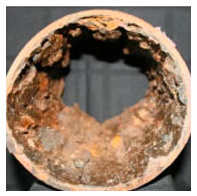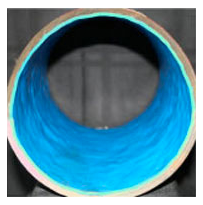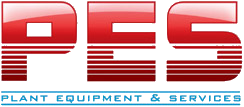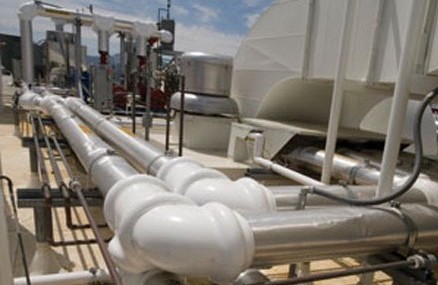Using epoxy coatings and epoxy-coated structural liners offers many benefits, including saving both time and money over traditional pipe repairs. Damaged or deteriorating pipe systems can be expensive to replace, especially those that are located in hard-to-reach locations or inaccessible without selective demolition. Fortunately, common pipe systems can be rehabilitated from within, utilizing cured-in-place epoxy coatings or epoxy-coated structural liners. These techniques of in situ pipe repair can offer cost savings of up to 60% and time savings of up to 30% when compared to traditional pipe repair methods. PES Solutions has partnered with Belco Pipe to provide the best in situ lining product for our customers. This article will highlight the types of pipe systems, cleaning and inspection process and the repairs we offer with in situ lining.
Pipe Systems, Sizing and Types
In situ pipe repair techniques can be used on a wide range of small-diameter pipes: compressed air and gas systems, HVAC systems, chemical supply lines, potable water pipes, sea-water cooling systems, storm drains and sanitary sewer lines. The idea is to strengthen and protect pipe walls from within without creating obstructions while minimizing repair costs and reducing system down time. Almost any pipe material can receive these treatments, including PVC, cast iron galvanized steel, copper and even concrete in some cases.
The piping systems with drains and cleanouts, such as gravity-flow sanitary sewer lines or roof drains and pressurized piping systems, are the two categories of piping systems where these repair techniques can be used.
With the exception that only specific epoxy coating types are compatible with NSF/ANSI Standard 61, approved for use in potable water pipes, cured-in-place epoxy coatings and epoxy-coated structural liners can be used on either piping system (those with drains or pressurized).
The technology can be applied in pipe systems that range from 1/2″ to 12″ in diameter. Structural liners can be placed in 3/4″ through 12″ diameter pipes. PES Solutions epoxy coatings can be installed in 1/2″ through 12″ diameter pipes and are used almost exclusively in 1/2″ to 2″ diameter pipes.
Figuring out the extent of the repairs required is the first step, regardless of the type of pipe system. If necessary, systems can be bypassed with temporary piping and can then be shut down, cleaned and inspected.
Cleaning and Inspection
Hot, clean, compressed air is run through the pipe network for pressurized pipe systems. The beginning air temperature at the compressor is around 130 degrees but usually decreases 85-90 degrees by the end of the pipe run. A dry garnet rock abrasive is then added to the compressed air flow and the abrasive and debris is captured by a cyclonic vacuum collector. For better adhesion of the epoxy resins, the abrasive additive provides an anchor tooth (close to 6 mils) throughout the pipe’s interior surface.
Existing drain lines and cleanouts are taken advantage of for drain pipe systems, providing convenient access points for cleaning tools, so there is no need to dig or create holes for access points. Cleanouts can be installed in a pipe run where they don’t already exist to better facilitate access for cleaning. Depending on the type of pipe and severity of buildup within, cleaning is accomplished with pneumatic tools or by hydro-jetting. Depending on the system conditions, different cleaning heads can also be placed on the cleaning tools.
Common issues discovered during inspection and assessments include pinhole leaks, breaks, corrosion, pitting, and buildup, the extent and location of which will determine the best repair method — a coating or a liner. Specific types of pipe systems will have commonly noted issues. For instance, galvanized steel potable water piping (popular in the 1950s and ’60s) is more likely to encounter interior buildup of metals that have precipitated out of solution — calcium and iron being the biggest buildup contributors. Copper water pipes are less likely to encounter interior buildup but commonly experience pinhole leaks.
Repairs with Cured-in-Place Epoxy Coatings
Epoxy coating repairs are more common when there’s no structural concerns noted within the pipe. The amount of epoxy coating material necessary is determined by a formula, which is the factors that determine the amount of coating material to apply are viscosity, pipe diameter and length of pipe run. Different epoxy coating products are offered for the various types of pipes and applications. The epoxy is applied throughout the interior diameter of the pipe network. The final target coating thickness is approximately 10 mils.
Repairs with Structural Pipe Liners
Drain pipe systems are repaired with structural liners. These liners cover the commonly found large breaks and holes in the failing drain pipes. Types of structural liners can vary, but some basic ideas apply. A fabric sock (felt is the the typical material), based on the type and condition of the pipe interior, is positioned inside a pipe length. For each individual application, the appropriate types and quantities of epoxy resins to coat the sock are calculated. The fabric sock is inflated with a pneumatic bladder that positions the fabric in place. This is even the case for pipes with non-circular cross-sections as well. The sock is then saturated with epoxy resins that cure and dry. Usually, the curing process takes about 4-5 hours before the pipe system is ready to use again.
Before, Cleaned and Lined



Not only do in situ linings provide time and cost benefits, they also provide benefits to facility managers and building owners to include the quieter, less intrusive workmanship that these methods allow. Contact PES Solutions for more information about in situ linings with the link below!


Amber Clay liked this on Facebook.